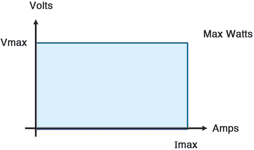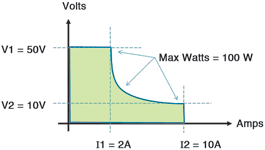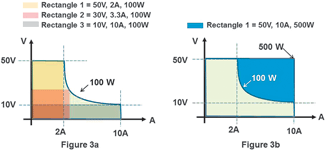
Autoranging power supplies, sometimes simply called autorangers, are designed to give a greater range of operation than a typical supply.
In this author’s estimation, less than 10% of the power supplies on the market are autoranging. To determine if you have an autoranger, look at the maximum rated volts, amps and output power. If maximum volts times maximum amps is greater than maximum watts, you have an autoranger.

Figure 1 shows the output characteristic of a typical non-autoranging power supply. This is called a rectangular output supply, because the diagram looks like a rectangle. The power supply can operate anywhere within these limits of voltage and current.
To determine if your supply can meet your sourcing needs, simply look at the ratings: if your required voltage is less than the rated voltage, and your required current is less than the rated current, you have what you need. The issue is the size (i.e., power rating) of the supply. While the supply is rated for a certain maximum power, you can only draw that maximum power when operating at maximum rated voltage and maximum rated current.
Autorangers explained

Figure 2 shows the output characteristic of a typical autoranging supply. The diagram’s key feature is the curve, which is the locus of points where voltage times current equals maximum power. At the ends of the curve, there is still a limit on voltage and a limit on current.
A figure of merit on autorangers is the ratio of voltage at the endpoints of the curve. For the output characteristic shown in Figure 2, the maximum voltage (let’s call this V1) is 50 V, at which you can draw 2 A because this is a 100 W supply. The maximum current you can draw is 10 A, at which the maximum voltage will be 10 V (let’s call this V2).
The ratio of V1/V2 is 5, so this is a 5:1 autoranger. As this ratio gets larger, the power supply is more flexible because it can operate over a wider range. Typical autorangers on the market today will be 2:1 to 5:1.
The downside of autorangers
Basically, an autoranging supply is a rectangular supply that is power limited to 1/2 or 1/3 or 1/5 of maximum voltage times its maximum current. While autorangers give greater application flexibility, they suffer from issues with accuracy.
Given the wide voltage and current range over which they operate, the built-in measurement system needs to operate too over this wide range. In the previous example, the measurement system must be sized for 50 V and 10 A even though this is only a 100 W supply. Stretching the measurement system over a wider range means you have to live with the extra inaccuracy, especially at the low end.
Autorangers tend to be 20-30% more expensive than their rectangular equivalents. There are several reasons for this higher cost. First, they need to have an additional control loop to keep the output power within the power envelope of the supply.
Second, the actual components involved must be rated for the highest voltage and the highest current, as these maximum conditions will appear at some point on the power components, although never at the same time. Lastly, to achieve the best possible measurement accuracy over this wider operating range will mean a more costly measurement system.
Autoranger vs rectangular: Is there a winner?
Because they operate over a wider range, autorangers can replace several rectangular output supplies of the same rating. Figure 3a shows how several rectangular output 100 W supplies are needed to match the ratings of a 100 W, 5:1 autoranger.

However, another approach is just to use a larger rectangular output supply. Figure 3b shows how using a 500 W rectangular output supply provides the same operating points as the 100 W 5:1 autoranger.
While there is something appealing about the flexibility and efficiency of the 100 W autoranger, a larger rectangular output supply may not be the lesser choice. To decide which is better, you would have to compare the cost and the physical size of the two alternatives.
While the autoranger may seem less costly and smaller than a supply of five times the output power, given today’s modern switching power supply designs, the size and cost of a 500 W rectangular output supply may be similar to the 100 W 5:1 autoranger.
When to select an autoranger
If your testing requires voltages over a limited range, the incremental cost of the autoranger means you are paying extra money for wide operating range flexibility that you don’t need. For example, if you are testing a mobile phone normally powered by a lithium-ion cell, its operating voltage will be between 4,2 V and 2,8 V; this is a pretty narrow range of operation and having an autoranger would be wasteful.
Conversely, if your testing requires a wide range of operation, an autoranger could be a highly valuable tool because it gives you more flexibility with a smaller power supply. This can really save cost and rack space.
For example, if you are a system integrator trying to create a flexible tester, you can probably justify the extra cost to give more flexibility. Or, if you are a DC/DC converter manufacturer testing a family of converters, you may need a DC source of 5 V to 72 V to cover the input requirements of the whole family.
Lastly, if measurement accuracy is not critical, perhaps because you add your own external measurement system to the power supply, then the reduced accuracy you may have with an autoranging supply won’t matter to you.
| Tel: | +27 12 678 9200 |
| Email: | [email protected] |
| www: | www.concilium.co.za/test-measurement |
| Articles: | More information and articles about Concilium Technologies |

© Technews Publishing (Pty) Ltd | All Rights Reserved